Did you know that in pre-colonial Philippines, some communities placed their dead in tree trunks and hung them in the forest canopy? This unique practice reflects the deep connection between the living and the deceased in ancient Filipino culture.
Death was not seen as an end but as a transition. Communities honored the body with rituals that ensured the soul’s safe passage to the afterlife. These traditions varied across regions, from cliff-side coffins to underground placements beneath homes.
These practices were more than just ways to handle the body. They were expressions of respect, spirituality, and community. Understanding these rituals offers a glimpse into the rich traditions that shaped Filipino beliefs about death and the afterlife.
Key Takeaways
- Pre-colonial practices honored the deceased with unique rituals.
- Death was viewed as a spiritual transition, not an end.
- Regional customs varied, from cliff burials to tree trunk placements.
- Rituals reflected respect for the body and the soul’s journey.
- These traditions highlight the cultural richness of ancient Filipino society.
Historical Context of Pre-Colonial Burial Practices
The roots of Filipino burial customs stretch back thousands of years. These practices were deeply tied to the beliefs and values of early communities. They reflect a unique blend of spirituality, respect, and cultural identity.
Archaeological finds provide a window into these ancient traditions. For example, discoveries of grave sites in the Philippines reveal how early Filipinos honored their dead. These sites often contained remains alongside personal belongings, showing a belief in an afterlife.
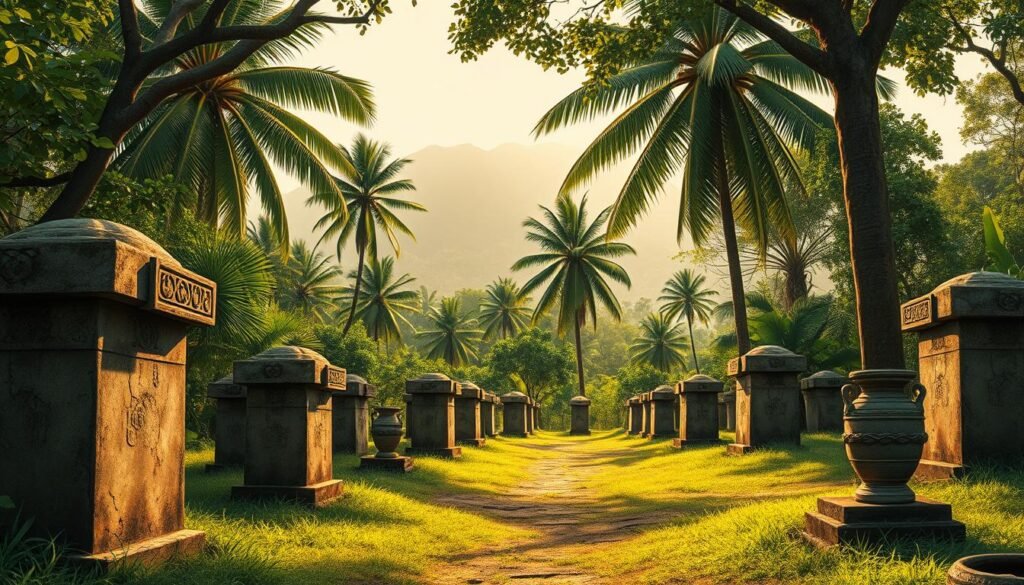
Early Evidence and Archaeological Finds
Early evidence of burial practices dates back to the Paleolithic period. In places like Kebara Cave, researchers found remains that suggest ritualistic burials. Similar findings in the Philippines highlight shared practices across regions.
For instance, the use of grave goods, such as tools and ornaments, was common. These items were placed with the deceased to aid their journey to the afterlife. Such practices show the importance of honoring the dead in early societies.
Comparative Timelines from Paleolithic to Medieval Periods
From the Paleolithic to the Medieval period, burial customs evolved significantly. In Europe, cliff-side graves and underground tombs became popular. In Asia, practices like tree trunk burials were widespread.
These changes reflect societal shifts over time. For example, the construction of elaborate grave structures in the Medieval period indicates a growing emphasis on status and remembrance. Such trends are also seen in pre-colonial Filipino practices.
Understanding these timelines helps us appreciate the cultural richness of ancient societies. Burial grounds serve as a testament to the values and beliefs of their time.
Spiritual Beliefs and Rituals in Death Customs
Ancient Filipino societies viewed death as a sacred journey, shaping their unique customs. These practices were deeply rooted in spiritual beliefs, reflecting a profound connection between the living and the deceased. For early Filipinos, death was not an end but a transition guided by rituals that ensured the soul’s safe passage to the afterlife.
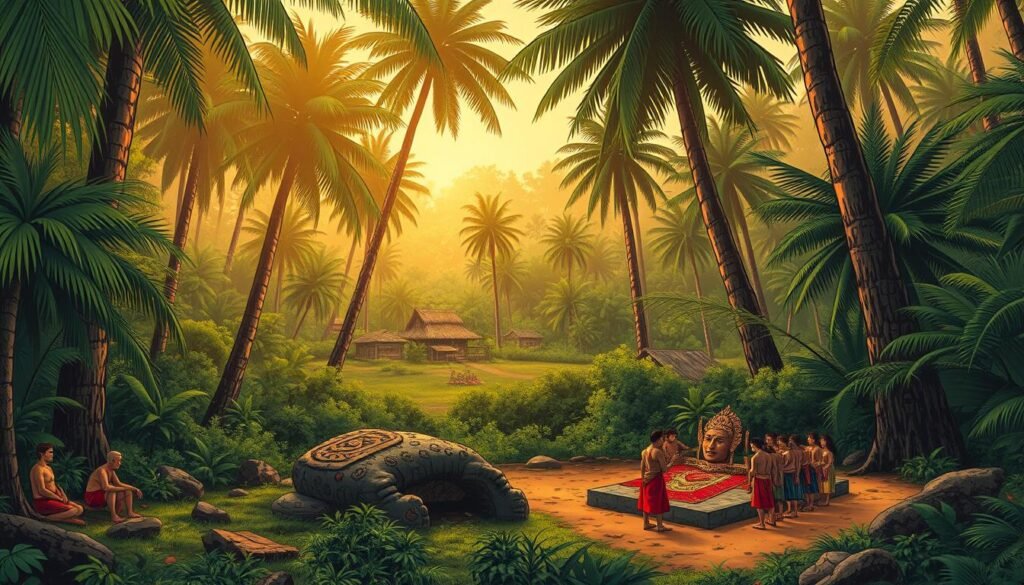
Central to these customs was the concept of the afterlife. Many believed that the soul continued to exist in another realm, influencing the lives of the living. This belief fostered a culture of ancestral worship, where the deceased were honored as protectors and guides. Rituals were performed to maintain harmony between the physical and spiritual worlds.
Concepts of the Afterlife and Ancestral Worship
The afterlife was seen as a place of rest and renewal. Early Filipinos believed that the soul’s journey depended on the respect shown during funeral rites. Proper handling of the body and ceremonial practices ensured the soul’s safe passage. Ancestors were revered, and their blessings were sought for prosperity and protection.
Specific rituals varied across regions but shared common themes. For example, the use of coffins or burial containers symbolized the transition from life to the afterlife. Personal belongings were often placed with the deceased, reflecting the belief that these items would aid the soul in its journey. These practices highlight the deep spiritual significance of death in pre-colonial culture.
Communal beliefs also played a vital role. Death was not just a personal event but a community affair. Funeral ceremonies brought people together, reinforcing social bonds and shared values. These traditions were passed down through generations, preserving the spiritual heritage of ancient Filipino society.
Burial Rituals in Pre-Colonial Society
In pre-colonial Philippines, the rituals surrounding death were deeply intertwined with spiritual beliefs and community practices. These customs were designed to honor the deceased and ensure their safe passage to the afterlife. From the preparation of the body to the placement of grave goods, every step held symbolic meaning.

Archaeological findings reveal that early Filipinos often buried their dead with personal belongings. These items, known as grave goods, were believed to assist the soul in its journey. Common grave goods included tools, ornaments, and even weapons, reflecting the deceased’s status and role in society.
The Role of Grave Goods in Spiritual Transition
Grave goods played a crucial role in pre-colonial funeral practices. They were not just objects but symbols of the deceased’s identity and their connection to the afterlife. For example, the Manunggul jars, discovered in Palawan, contained anthropomorphic figures and were used as burial containers. These artifacts highlight the belief in a spiritual journey beyond death.
The preparation of the corpse was equally significant. In some regions, the deceased were dressed in fine garments and placed in a seated position. This ritualistic preparation ensured the body was ready for its final resting place. The use of ceremonial objects, such as gold ornaments, further emphasized the importance of these practices.
| Practice | Significance |
|---|---|
| Grave Goods | Assisted the soul’s journey to the afterlife |
| Preparation of the Body | Ensured respect and readiness for the spiritual transition |
| Ceremonial Objects | Symbolized the deceased’s status and beliefs |
Cemeteries and specific burial sites were also integral to these rituals. These locations were often chosen for their spiritual significance, such as cliffs or forested areas. The communal nature of funeral ceremonies reinforced social bonds and shared values, ensuring the deceased were honored collectively.
Funerary Ceremonies and Grave Goods
In ancient times, funerary ceremonies in the Philippines were deeply symbolic, reflecting the community’s spiritual beliefs and respect for the deceased. These rituals were not just about laying the body to rest but ensuring the soul’s safe passage to the afterlife. From the preparation of the corpse to the placement of grave goods, every step held profound meaning.
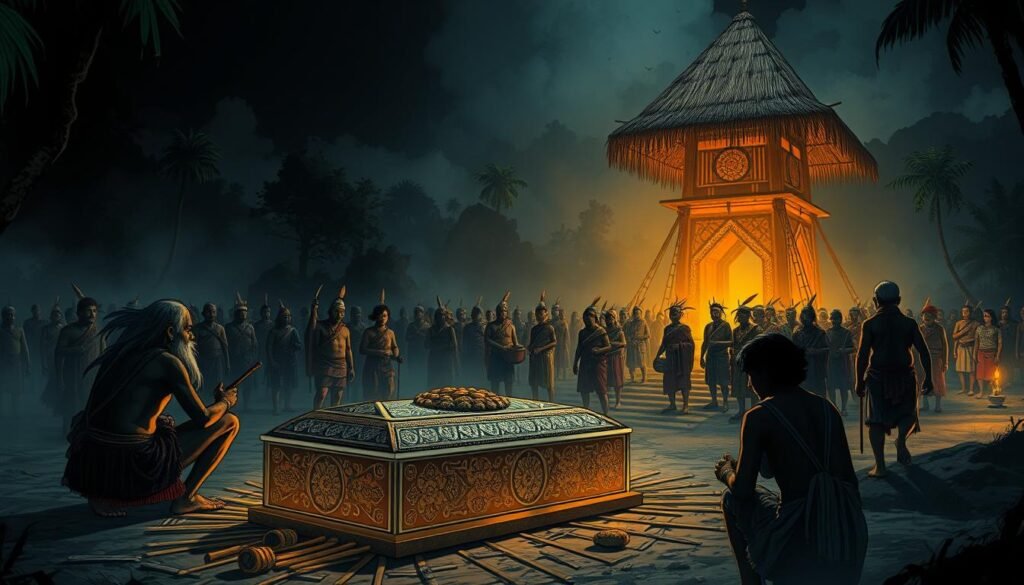
Ritualistic Use of Coffins and Burial Containers
Coffins and burial containers played a central role in these ceremonies. In some regions, the deceased were placed in intricately designed coffins, often made from wood or clay. These containers were not just practical but also symbolic, representing the transition from life to the afterlife.
For example, the Manunggul jars, discovered in Palawan, were used as burial containers. These jars featured anthropomorphic figures, symbolizing the soul’s journey. Such artifacts highlight the importance of these containers in ancient Filipino traditions.
Significance of Personal Belongings in Ceremonies
Personal belongings were often interred with the deceased, serving both practical and symbolic roles. These items, known as grave goods, included tools, ornaments, and even weapons. They were believed to assist the soul in its journey to the afterlife.
In some cases, these objects were chosen based on the deceased’s status or role in society. For instance, a warrior might be buried with a sword, while a craftsman could be interred with their tools. This practice emphasized the individual’s identity even in death.
The timing of these ceremonies was also significant. Many rituals were performed at specific times, such as dawn or dusk, to align with spiritual beliefs. These practices ensured that the deceased were honored in a manner that reflected their time and place in the community.
To learn more about how these traditions influenced later periods, explore the ancient Filipino traditions that shaped the region’s cultural heritage.
Burial Sites and Their Archaeological Significance
Archaeological discoveries in the Philippines reveal a rich tapestry of ancient burial sites, each telling a unique story of cultural heritage. These sites offer a glimpse into the practices and beliefs of pre-colonial societies, highlighting their deep connection to the land and the afterlife.
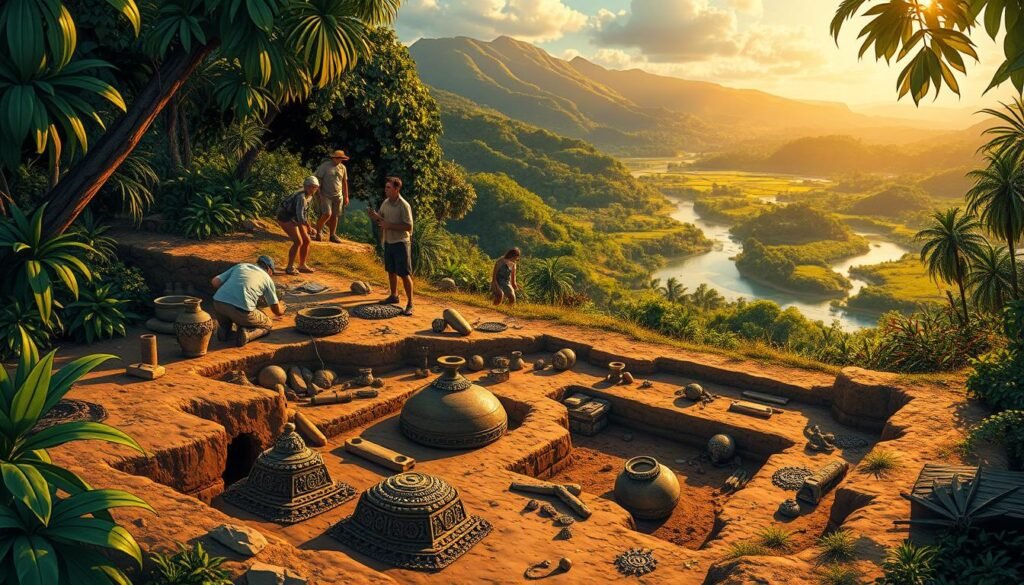
From the intricate tomb structures in the highlands to the coastal cemetery sites, each location reflects regional variations in burial customs. These differences are not just about the place but also the materials and methods used, showcasing the diversity of ancient Filipino culture.
Notable Discoveries and Regional Variations
One of the most significant discoveries is the Manunggul jar, a burial container found in Palawan. This artifact, with its anthropomorphic designs, symbolizes the journey of the soul to the afterlife. Such findings highlight the spiritual significance of these sites.
In the Cordillera region, tombs carved into cliffs demonstrate a unique approach to honoring the deceased. These structures, often accompanied by grave goods, reflect the community’s respect for the body and its journey beyond death.
“The discovery of these sites provides invaluable insights into the beliefs and practices of ancient societies, bridging the gap between the past and the present.”
Archaeological methods, such as stratigraphy and carbon dating, have been crucial in uncovering the historic context of these sites. For example, ground-penetrating radar has revealed hidden underground features, offering new perspectives on ancient burial practices.
| Region | Burial Practice | Significance |
|---|---|---|
| Palawan | Jar Burials | Symbolizes the soul’s journey |
| Cordillera | Cliff Tombs | Reflects community respect |
| Visayas | Tree Trunk Burials | Connects the deceased to nature |
To learn more about how these traditions influenced later periods, explore the ancient Filipino traditions that shaped the region’s cultural heritage.
Symbolism of the Coffin, Tomb, and Grave Structures
The design of coffins, tombs, and grave structures in pre-colonial Philippines reveals deep symbolic meanings tied to cultural beliefs. These structures were not just physical resting places but also spiritual gateways, reflecting the community’s connection to the afterlife. Every element, from the shape of the coffin to the placement of the tomb, carried profound significance.
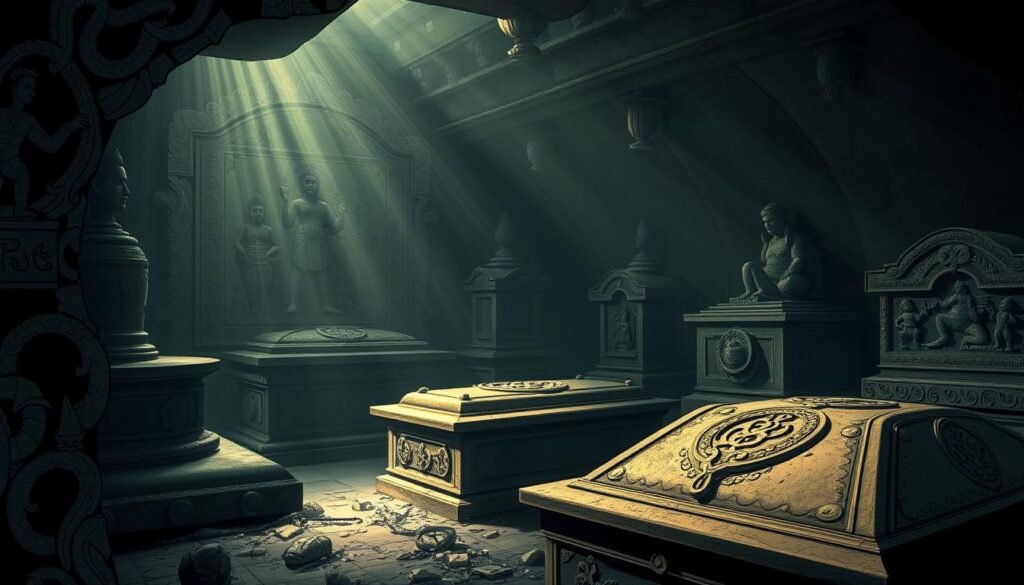
For instance, the Manunggul jar, a burial container from Palawan, features intricate designs symbolizing the soul’s journey. Such artifacts highlight how ancient Filipinos viewed death as a transition rather than an end. The grave structures were designed to honor the deceased and ensure their safe passage to the spiritual world.
Architectural Elements in Burial Constructions
The architecture of burial sites in pre-colonial Philippines was both functional and symbolic. Tombs were often carved into cliffs or built with natural materials, blending human design with the environment. These structures reflected the community’s respect for the deceased and their belief in an afterlife.
For example, in the Cordillera region, cliff-side tombs were adorned with grave goods like tools and ornaments. These items were believed to assist the soul in its journey. The use of such architectural elements underscores the cultural richness of ancient Filipino society.
Integration of Natural Elements in Earth Mounds
Natural elements played a crucial role in burial practices. Earth mounds, for instance, were often used to create burial sites that merged seamlessly with the landscape. These mounds symbolized the connection between the deceased and the natural world.
In some regions, the deceased were placed in tree trunks or buried beneath homes, further emphasizing this connection. Such practices highlight the belief that death was not an end but a return to nature. The integration of natural elements in burial sites reflects the deep spiritual beliefs of ancient Filipinos.
“The design of burial structures in pre-colonial Philippines reveals a profound understanding of life, death, and the spiritual journey.”
To explore more about the cultural significance of these practices, visit this detailed resource on funerary art.
Natural and Eco-Friendly Burial Methods in History
Long before modern eco-conscious practices, ancient societies embraced natural methods to honor the deceased. These traditions were deeply rooted in respect for the culture and the environment, reflecting a harmonious relationship between life and nature. From the use of water to the careful handling of ash, these methods ensured the dead body returned to the earth in a sustainable way.

Pre-Colonial Practices Aligned with Nature
In pre-colonial times, many communities employed natural burial techniques that minimized environmental impact. For example, some groups used water as part of the process, allowing the dead body to decompose naturally. This method not only respected the person but also preserved the surrounding ecosystem.
Other practices included placing the deceased in biodegradable materials, such as woven mats or tree trunks. These methods ensured that the body returned to the earth without leaving harmful residues. Such traditions highlight the early understanding of sustainability in culture.
Early Forms of Green and Conservation Burials
Early green burials focused on conservation and ecological balance. Communities often chose burial sites in forests or near water sources, ensuring the land remained fertile and biodiverse. These practices were not just about honoring the person but also about protecting the environment for future generations.
Cremation was another eco-friendly method, with the ash often scattered in meaningful locations. This process symbolized the return of the person to nature, reinforcing the connection between life and the earth. These traditions laid the foundation for modern green burial practices, which continue to gain popularity today.
“Ancient burial methods remind us that sustainability is not a modern concept but a timeless value deeply embedded in human culture.”
To learn more about the evolution of these practices, explore the history of green burials and their impact on modern culture.
Influence of Pre-Colonial Burial Traditions on Modern Culture
The echoes of pre-colonial Filipino traditions continue to shape modern practices surrounding death and remembrance. These ancient customs, rooted in spirituality and community, have evolved but remain deeply embedded in today’s society. From rituals to the use of natural elements, the influence of these traditions is evident in how Filipinos honor the deceased.
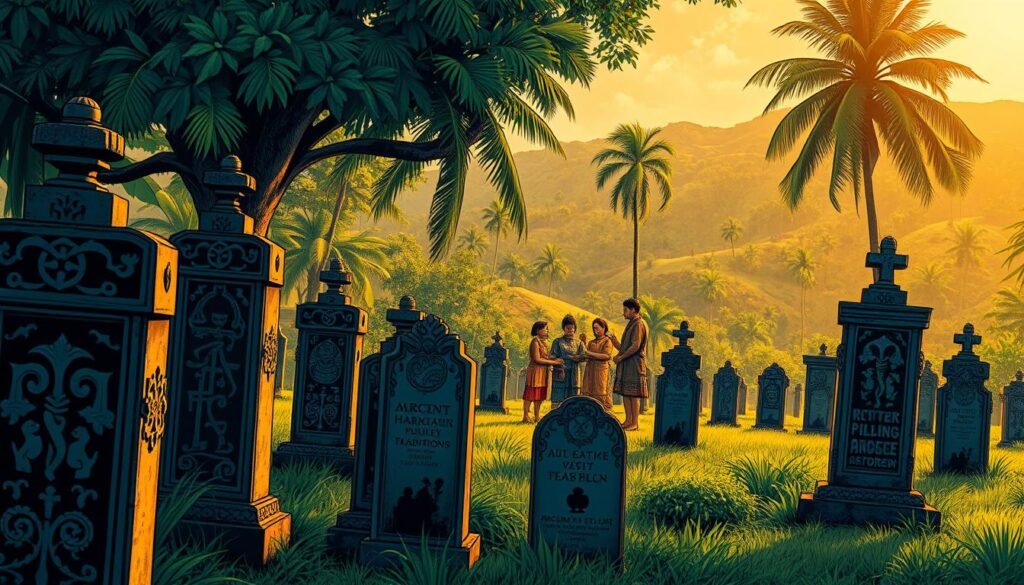
One striking example is the practice of paglalamay, a vigil held for the deceased. This tradition, rooted in the belief of protecting the remains from harm, is still widely observed. Families gather to offer prayers and support, reflecting the communal spirit of ancient Filipino culture.
Modern Adaptations of Ancient Rituals
Modern ceremonies often incorporate elements from pre-colonial times. For instance, the use of natural symbols like birds and open space reflects the ancient belief in the soul’s journey. These adaptations show how traditions evolve while maintaining their core significance.
In some cases, ancient artifacts like the Manunggul jars inspire contemporary designs. These jars, dating back to 710 BC, symbolize the soul’s transition and are now referenced in modern society as a connection to the past. Such practices highlight the enduring relevance of pre-colonial customs.
“The blending of ancient and modern traditions reminds us that honoring the deceased is a timeless act of respect and love.”
To explore more about how these traditions continue to influence modern practices, visit this detailed resource on Filipino traditions for death.
Conclusion
Pre-colonial Philippine practices surrounding death reveal a profound connection between the living and the deceased. From the use of coffins to cremation and water-based methods, these traditions were deeply rooted in spiritual beliefs. The ground and grave sites held significant cultural meaning, serving as sacred spaces for honoring the body and ensuring the soul‘s journey to the afterlife.
These ancient rituals, such as placing remains in tree trunks or cliff-side tombs, reflect a harmonious relationship with nature. The inclusion of personal belongings in funeral ceremonies highlights the belief in continuity beyond death. These practices were not just about the corpse but about preserving community bonds and shared values.
Today, these traditions continue to influence modern Filipino culture, shaping how society honors life and death. The rituals of the past remind us of the enduring connection between the living and the deceased. To explore more about these practices, visit this detailed resource on Catholic Funeral Rites.
FAQ
What were the key spiritual beliefs influencing pre-colonial Philippine burial practices?
Pre-colonial Filipinos believed in an afterlife and ancestral worship. They thought that the soul continued to exist after death, and proper rituals ensured a smooth transition to the spiritual realm.
How did grave goods play a role in pre-colonial burials?
Grave goods, such as tools, jewelry, and personal belongings, were placed with the deceased to aid their journey in the afterlife. These items symbolized status and were believed to provide comfort in the spiritual world.
What types of burial containers were used in pre-colonial Philippines?
Coffins, urns, and wooden caskets were common. Some cultures used natural elements like bamboo or woven mats to encase the body, reflecting their connection to nature.
Are there notable archaeological discoveries of pre-colonial burial sites in the Philippines?
Yes, sites like the Manunggul Cave in Palawan and the Tabon Caves have revealed ancient remains, coffins, and grave goods, offering insights into early burial customs and regional variations.
How did pre-colonial burial practices integrate natural elements?
Earth mounds, caves, and trees were often used as burial sites. These methods aligned with eco-friendly practices, emphasizing harmony with the environment.
How have pre-colonial burial traditions influenced modern Filipino culture?
Modern practices, such as the use of family tombs and the inclusion of personal items in ceremonies, reflect adaptations of ancient rituals. These traditions continue to honor ancestral beliefs.
What was the significance of funerary ceremonies in pre-colonial society?
Funerary ceremonies were essential for guiding the soul to the afterlife. They involved rituals, chants, and offerings, reinforcing community bonds and spiritual beliefs.
Did pre-colonial burial practices vary across regions in the Philippines?
Yes, practices differed based on geography and culture. Coastal communities often used boat-shaped coffins, while inland groups preferred cave burials or earth mounds.
What role did architecture play in pre-colonial burial structures?
Burial sites often featured symbolic designs, such as carvings or alignments with natural landmarks. These elements reflected the community’s spiritual and cultural values.
Were pre-colonial burial methods eco-friendly?
Many practices, such as using biodegradable materials and natural sites, were inherently eco-friendly. These methods minimized environmental impact and aligned with sustainable principles.
Source Links
- Funeral Rites in the Philippines: Honoring the Departed – Pinas Culture
- Ancient Filipino Perspectives On the Afterlife
- Death rite | anthropology | Britannica
- Fire and fear: Rapid cremations in the Philippines amidst COVID-19
- Factsheet: Death and funerals in world religions – Religion Media Centre
- 5. Funeral practices and beliefs about the afterlife
- Funeral practices and burial customs in the Philippines
- Death in pre-colonial times
- Pre-colonial burial traditions – National Museum
- Death, Burial, and the Afterlife in Ancient Greece – The Metropolitan Museum of Art
- Ancient Egyptian funerary practices
- Burial in Ancient Mesopotamia
- Determining which archaeological sites are significant: Evaluation
- Burial: Cultural Significance & Techniques
- Cradle to Coffin: A Semiotic Model of Life and Death
- Roman funerary art
- The History Of Green Burial – Green Cremation Texas – Austin Funeral Home
- Natural burial
- The History and Philosophy Behind Natural Burial Practices
- Contemporary Undas practices derived from pre-colonial influence, beliefs – cultural anthropologist
- Filipino Death Traditions Continued: The Indigenous People
- Religious Experiences and Spirituality: Indigenous Religions in Pre-colonial Philippines
- Burial | Types, Practices, & Facts | Britannica
- An Overview of Catholic Funeral Rites
- Cremation and Grief: Are Ways of Commemorating the Dead Related to Adjustment Over Time?

